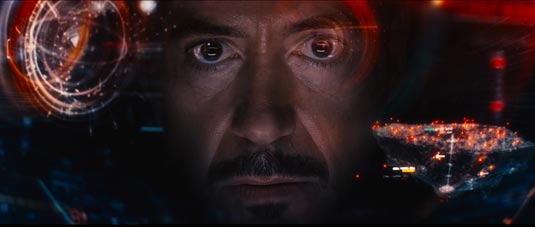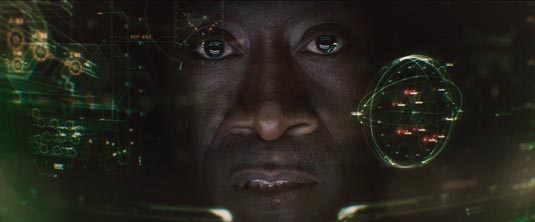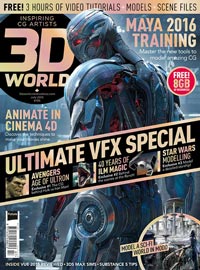The Cinema 4D secrets of Iron Man's interface

It's one of the most iconic interfaces in movie history – Tony Stark's holographic HUD (heads-up display) has been an integral part of all the Iron Man movies to date.
So when Cantina Creative and Territory Studio were given the job, among others, of creating it for one of the biggest 3D movies of 2015, Avengers: Age of Ultron, it was a huge responsibility to the franchise's millions of fans.
Pushing the quality
Cantina Creative had designed HUDS and interface graphical designs in Iron Man 3, Iron Man 2 and The Avengers. But resting on their laurels wouldn't be an option.
For this sequel, they were asked to push photographic quality to the next level in the development and execution of 3D HUDS, as well as story point elements and monitor graphics designs.
The Cantina Creative VFX team members, headed by VFX Supervisor, Alan Torres, worked directly with Christopher Townsend, VFX Supervisor at Marvel Studios, to create more than 95 visual effects shots including a number of new Heads Up Displays (HUDS).
And as Torres explains, they used Cinema 4D as a key tool in providing a heightened visual sense of space and lighting within all four of the new HUDS, namely Iron Man's Mark 42, Mark 43, Mark 44 and Mark 45 armored suits.
"As Tony Stark continues to evolve, so must his toys," explains Torres. "Cinema 4D helped us conceptualize, develop and ultimately solve the creation of several challenging new assets to tell the story the way we intended and create elaborate, 3D photoreal and dimensional environments in the HUDS so that Stark can maneuver in a truly interactive manner."
Daily design news, reviews, how-tos and more, as picked by the editors.
Adds Stephen Lawes, Cantina Creative's creative director: "We relied on numerous features in Cinema 4D to generate, animate and render HUD assets on many of the most challenging shots we delivered for an efficient and intuitive workflow.
For example, in a key point-of-view sequence for the Mark 45 where Tony Stark scans a church key that runs through the rising section of earth, the team needed to transition from a live action plate to a CG schematic.
"Using the camera and tracking data in Cinema 4D allowed us to import the church key model (supplied by ILM) and after developing the schematic look of the key we were intuitively able to animate and then render passes into After Effects for compositing."
Visual language
Under the direction of creative director David Sheldon-Hicks, the Territory team also worked closely with Townsend, Age of Ultron production designer Charles Wood and the art department to craft a visual language for the film's super heroes and their technology.

Territory create new visual identities and UI designs for the technology seen in Stark's lab, Banner's research lab, the Quinjet aircraft, the fortress of Baron Von Strucker and Dr. Cho's advanced medical lab, as seen in this showreel.
For authenticity, they carried out research in the fields of military, robotics and avionics technology.
"In Age of Ultron our 3D visuals needed to tell a story in the blink of an eye while retaining enough detail for close scrutiny on a cinema projection," explains Sheldon-Hicks.
"Cinema 4D allows us to think like designers, work quickly and creatively and push ourselves technically to discover new techniques.
"Its tight workflow with other tools such as After Effects is also an essential aspect when working against tight deadlines, and allowed us to render an element while compositing and animating continuously."
Detailed models
Territory drew upon various toolsets within Cinema 4D including Thinking Particles, Mograph and Sketch and Toon for quick render passes, mesh organization, and for creative experimentation.
"For the Leviathan screens, created for the Fortress set, we took a highly detailed CGI model received from one of the main vendors to organize the mesh into manageable chunks and to experiment with different setups," says Peter Eszenyi, head of 3D, Territory Studios.

"Cinema 4D gave us the flexibility to explore using the mesh as an emitter as well as placing several other emitters around it. For other passes we used the mesh as a collider object, and of course we did quite a few different setups with turbulences, wind, surface modifiers -- the whole works.
"In parallel we also used the Sketch and Toon module to experiment with different contour settings, lights and shadows and also 'played around' after rendering the passes with shadows, ambient occlusion, tessellation methods, and projection so we could start producing the different screens."
What's your favourite VFX movie? Take part in our survey and you could win a subscription to 3D World magazine!
More Age of Ultron secrets revealed!

In issue 196 of 3D World magazine discover how ILM created the stellar VFX behind Avengers: Age of Ultron plus learn how to model an epic spaceship in ZBrush with Star Wars superfan Ansel Hsiao, concepting and model a sci-fi world in Modo, master Maya 2016, Cinema 4D animation techniques and more!. Issue 196 is currently on sale in US bookstores or buy your copy here.
Like this? Read these!
- How to illustrate an Ironman-style holographic interface
- Hands-on review: Adobe After Effects CC
- Download free textures: high resolution and ready to use now

Tom May is an award-winning journalist specialising in art, design, photography and technology. His latest book, The 50 Greatest Designers (Arcturus Publishing), was published this June. He's also author of Great TED Talks: Creativity (Pavilion Books). Tom was previously editor of Professional Photography magazine, associate editor at Creative Bloq, and deputy editor at net magazine.
